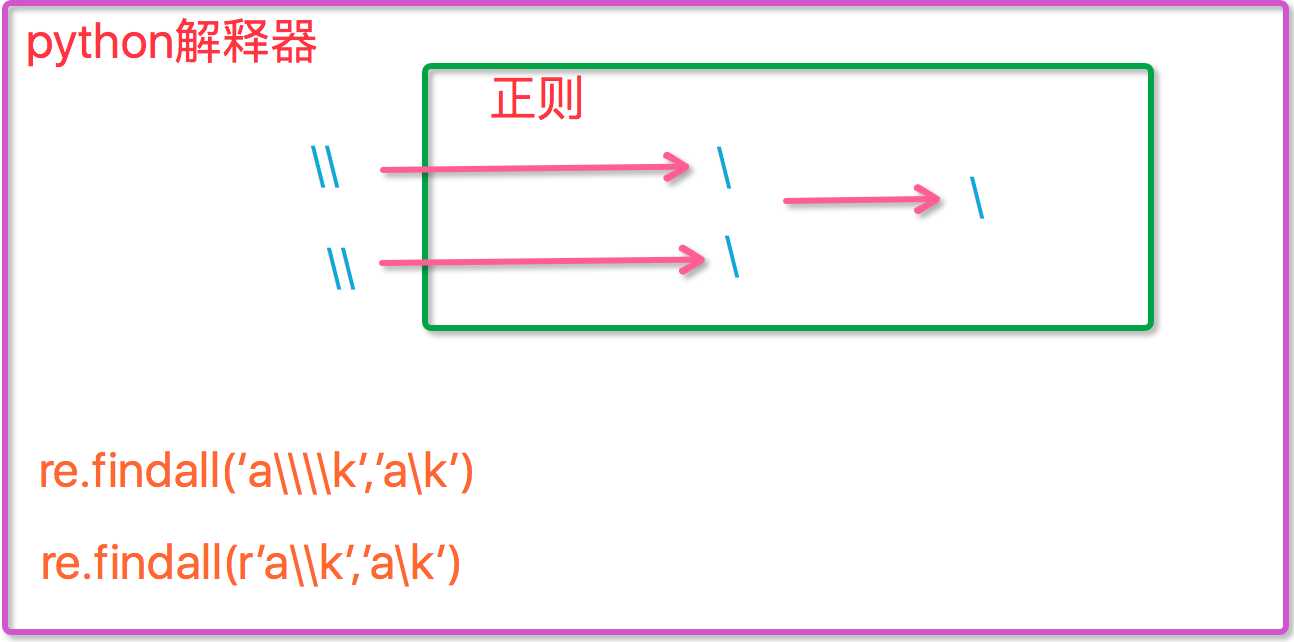Python正则RE
Posted
tags:
篇首语:本文由小常识网(cha138.com)小编为大家整理,主要介绍了Python正则RE相关的知识,希望对你有一定的参考价值。
就其本质而言,正则表达式(或 RE)是一种小型的、高度专业化的编程语言,(在Python中)它内嵌在Python中,并通过 re 模块实现。正则表达式模式被编译成一系列的字节码,然后由用 C 编写的匹配引擎执行。
RE字符:
元字符:. ^ $ * + ? { } [ ] | ( ) \\
普通字符:字母数字
1 import re 2 3 ret=re.findall(‘a..in‘,‘helloalvin‘) #.匹配一个字符 4 print(ret)#[‘alvin‘] 5 6 7 ret=re.findall(‘^a...n‘,‘alvinhelloawwwn‘) #^从开头匹配 8 print(ret)#[‘alvin‘] 9 10 11 ret=re.findall(‘a...n$‘,‘alvinhelloawwwn‘)#$从末尾匹配 12 print(ret)#[‘awwwn‘] 13 14 15 ret=re.findall(‘a...n$‘,‘alvinhelloawwwn‘) 16 print(ret)#[‘awwwn‘] 17 18 19 ret=re.findall(‘abc*‘,‘abcccc‘)#贪婪匹配[0,+oo] *前面的字母有0个或者多个 20 print(ret)#[‘abcccc‘] 21 22 ret=re.findall(‘abc+‘,‘abccc‘)#[1,+oo] +前面的字母有0个或者多个 23 print(ret)#[‘abccc‘] 24 25 ret=re.findall(‘abc?‘,‘abccc‘)#[0,1] ?前面的字母1个或者0个 26 print(ret)#[‘abc‘] 27 28 29 ret=re.findall(‘abc{1,4}‘,‘abccc‘) 30 print(ret)#[‘abccc‘] 贪婪匹配
注意:前面的*,+,?等都是贪婪匹配,也就是尽可能匹配,后面加?号使其变成惰性匹配
ret=re.findall(‘qta*?‘,‘qtaaaasd‘) print(ret) #[‘qt‘]
元字符之字符集[]:
ret=re.findall(‘a[bc]d‘,‘abdacd‘) print(ret) #[‘abd‘, ‘acd‘]
ret=re.findall(‘a[a-z]d‘,‘abdacd‘)
print(ret) #[‘abd‘, ‘acd‘]
ret=re.findall(‘[.*,]‘,‘ab,da.c*d‘)
print(ret)#[‘,‘, ‘.‘, ‘*‘]
ret=re.findall(‘[^.*,]‘,‘ab,da.c*d‘) #不包含字符集内的元素
print(ret) # [‘a‘, ‘b‘, ‘d‘, ‘a‘, ‘c‘, ‘d‘]
ret=re.findall(‘[\\d]‘,‘ab,da.c*d123‘) #\\d匹配任何数字 和[1-9]一样
print(ret) #[‘1‘, ‘2‘, ‘3‘]
ret=re.findall(‘[\\D]‘,‘ab,da.c*d123‘) #\\D匹配所有不是数字的字符
print(ret)# [‘a‘, ‘b‘, ‘,‘, ‘d‘, ‘a‘, ‘.‘, ‘c‘, ‘*‘, ‘d‘]
ret=re.findall(‘[\\w]‘,‘ab,da.c*d123‘)#\\w匹配任何数字和字符类似[1-9a-zA-Z]
print(ret) #[‘a‘, ‘b‘, ‘d‘, ‘a‘, ‘c‘, ‘d‘, ‘1‘, ‘2‘, ‘3‘]
ret=re.findall(‘[\\W]‘,‘ab,da.c*d123‘) #\\W匹配任何不是数字和字符的
print(ret) #[‘,‘, ‘.‘, ‘*‘]
ret=re.findall(‘[\\s]‘,‘ab,da.c*d123\\t\\n‘) #\\s匹配任何空白字符
print(ret) #[‘\\t‘, ‘\\n‘]
ret=re.findall(‘[\\S]‘,‘ab,da.c*d123\\t\\n‘) #\\S匹配任何不是空白字符
print(ret) #[‘a‘, ‘b‘, ‘,‘, ‘d‘, ‘a‘, ‘.‘, ‘c‘, ‘*‘, ‘d‘, ‘1‘, ‘2‘, ‘3‘]
元字符之转义符\\
反斜杠后边跟元字符去除特殊功能,比如\\.
反斜杠后边跟普通字符实现特殊功能,比如\\d
\\d 匹配任何十进制数;它相当于类 [0-9]。
\\D 匹配任何非数字字符;它相当于类 [^0-9]。
\\s 匹配任何空白字符;它相当于类 [ \\t\\n\\r\\f\\v]。
\\S 匹配任何非空白字符;它相当于类 [^ \\t\\n\\r\\f\\v]。
\\w 匹配任何字母数字字符;它相当于类 [a-zA-Z0-9_]。
\\W 匹配任何非字母数字字符;它相当于类 [^a-zA-Z0-9_]
\\b 匹配一个特殊字符边界,比如空格 ,&,#等
现在我们聊一聊\\,先看下面两个匹配:
1 #-----------------------------eg1: 2 import re 3 ret=re.findall(‘c\\l‘,‘abc\\le‘) 4 print(ret)#[] 5 ret=re.findall(‘c\\\\l‘,‘abc\\le‘) 6 print(ret)#[] 7 ret=re.findall(‘c\\\\\\\\l‘,‘abc\\le‘) 8 print(ret)#[‘c\\\\l‘] 9 ret=re.findall(r‘c\\\\l‘,‘abc\\le‘) 10 print(ret)#[‘c\\\\l‘] r说明再python用原生字符串 11 12 #-----------------------------eg2: 13 #之所以选择\\b是因为\\b在ASCII表中是有意义的 14 m = re.findall(‘\\bblow‘, ‘blow‘) 15 print(m) 16 m = re.findall(r‘\\bblow‘, ‘blow‘) 17 print(m)

元字符之分组()
1 m = re.findall(‘(bl)‘, ‘blow‘) #整体匹配‘bl’ 2 print(m) #[‘bl‘]
元字符之|
ret=re.search(‘(ab)|\\d‘,‘rabhdg8sd‘) #或,从左开始匹配,如果有匹配出来,如果没有匹配右边的 print(ret.group())#ab
RE的五种基本操做
re.match(pattern, string) # 从头匹配 re.search(pattern, string) # 匹配整个字符串,直到找到一个匹配 re.split() # 将匹配到的格式当做分割点对字符串分割成列表 >>>m = re.split("[0-9]", "alex1rain2jack3helen rachel8") >>>print(m) 输出: [‘alex‘, ‘rain‘, ‘jack‘, ‘helen rachel‘, ‘‘] re.findall() # 找到所有要匹配的字符并返回列表格式 >>>m = re.findall("[0-9]", "alex1rain2jack3helen rachel8") >>>print(m)<br> 输出:[‘1‘, ‘2‘, ‘3‘, ‘8‘] re.sub(pattern, repl, string, count,flag) # 替换匹配到的字符 m=re.sub("[0-9]","|", "alex1rain2jack3helen rachel8",count=2 ) print(m) 输出:alex|rain|jack3helen rachel8
以上是关于Python正则RE的主要内容,如果未能解决你的问题,请参考以下文章